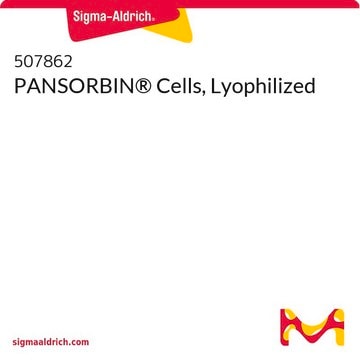507861
PANSORBIN® Cells, Standardized
Synonym(s):
Cell standard
Sign Into View Organizational & Contract Pricing
All Photos(1)
About This Item
UNSPSC Code:
41116133
NACRES:
NA.42
Recommended Products
form
liquid
Quality Level
contains
0.1% sodium azide as preservative
manufacturer/tradename
Calbiochem®
storage condition
do not freeze
capacity
≥2 mg/mL binding capacity
shipped in
ambient
storage temp.
2-8°C
General description
Heat-killed, formalin-fixed Staphylococcus aureus cells (Cowan I strain) that bear a high cell-surface density of protein A and have been pickled by the method of Kessler. Useful as a solid-phase IgG-binding reagent due to the high-affinity interaction of protein A with the Fc domain of IgG. PANSORBIN cells work best when the antibody is human (IgG1, IgG2, IgG4), rabbit IgG (all isotypes), or mouse (IgG2a, IgG2b, IgG3).
PANSORBIN Cells are heat-killed, formalin fixed Staphylococcus aureus cells that have a coat of protein A and have been pickled by the method of Kessler. Useful for mitogenic stimulation of B lymphocytes and for immunoprecipitation.
Application
Most common applications include immunoprecipitation and mitogenic stimulation of B lymphocytes.
Warning
Toxicity: Standard Handling (A)
Physical form
Supplied as a ≥10% (w/v) Staphylococcus aureus cell suspension in PBS, 0.1% sodium azide, pH 7.2.
Other Notes
Kierszenbaum, F., et al. 1991. Immunology74, 317.
Meikle, P.J., et al. 1991. J. Biol. Chem.266, 22569.
Ezaki, O., et al. 1989. Biochem. Biophys. Res. Commun. 159, 1368.
Murakami, H., et al. 1988. Biochem. J.256, 917.
Kessler, S.W. 1975. J. Immunol. 115, 1617.
Meikle, P.J., et al. 1991. J. Biol. Chem.266, 22569.
Ezaki, O., et al. 1989. Biochem. Biophys. Res. Commun. 159, 1368.
Murakami, H., et al. 1988. Biochem. J.256, 917.
Kessler, S.W. 1975. J. Immunol. 115, 1617.
Legal Information
CALBIOCHEM is a registered trademark of Merck KGaA, Darmstadt, Germany
PANSORBIN is a registered trademark of Merck KGaA, Darmstadt, Germany
Signal Word
Warning
Hazard Statements
Precautionary Statements
Hazard Classifications
Acute Tox. 4 Oral
Storage Class Code
12 - Non Combustible Liquids
WGK
WGK 3
Flash Point(F)
Not applicable
Flash Point(C)
Not applicable
Certificates of Analysis (COA)
Search for Certificates of Analysis (COA) by entering the products Lot/Batch Number. Lot and Batch Numbers can be found on a product’s label following the words ‘Lot’ or ‘Batch’.
Already Own This Product?
Find documentation for the products that you have recently purchased in the Document Library.
K E Reed et al.
Methods in molecular medicine, 19, 331-342 (1999-01-01)
Heterologous expression systems have been widely used to study hepatitis C virus (HCV) proteins in lieu of an efficient method for establishing HCV infections in cell culture. Studies of HCV polyprotein processing in both mammalian-cell-based and cell-free expression systems have
A Hasebe et al.
Clinical and experimental immunology, 139(1), 35-42 (2004-12-21)
The chronic hepatitis B virus (HBV) carrier exhibits ongoing replication of HBV and expresses abundant amounts of HBV-related antigens in the liver. However, HBV-specific immune responses are either absent or narrowly focused in these subjects. With the postulation that impaired
Chad E Mire et al.
Journal of virology, 83(23), 12139-12150 (2009-09-25)
To study vesicular stomatitis virus (VSV) entry and uncoating, we generated a recombinant VSV encoding a matrix (M) protein containing a C-terminal tetracysteine Lumio tag (rVSV-ML) that could be fluorescently labeled using biarsenical compounds. Quantitative confocal microscopy showed that there
F Beiranvand et al.
British journal of pharmacology, 171(23), 5209-5224 (2014-07-22)
Nicotinic acetylcholine receptors (nACh receptors) play a central role in the habenulo-interpeduncular system. We studied nicotine-induced release of NA and ACh in the habenula and interpeduncular nucleus (IPN). The habenula and IPN were loaded with [(3) H]-choline or [(3) H]-NA
Maria Forlenza et al.
Journal of immunology (Baltimore, Md. : 1950), 183(8), 5319-5332 (2009-09-30)
Functional characterization of TNF-alpha in species other than mammalian vertebrates is limited, and TNF-alpha has been studied in a limited number of fish species, primarily in vitro using recombinant proteins. Studies on TNF-alpha from different fish species so far pointed
Our team of scientists has experience in all areas of research including Life Science, Material Science, Chemical Synthesis, Chromatography, Analytical and many others.
Contact Technical Service








